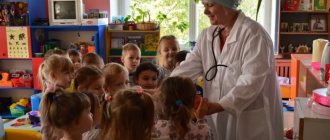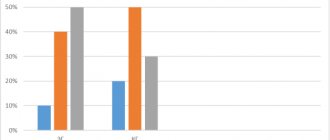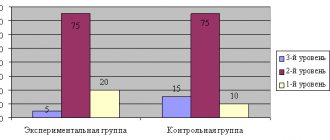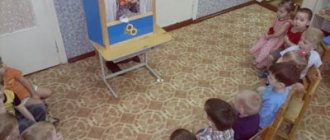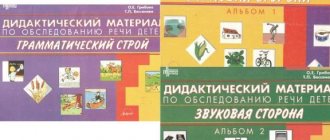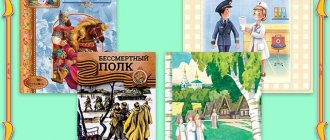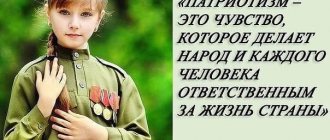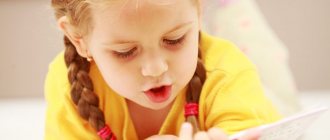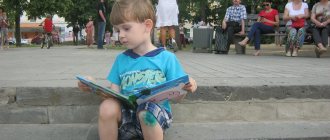The role of children's fiction in the formation of personality and all-round development of the child
Introduction
Preschool childhood as a period in human life plays an important role in shaping what not only each individual person will become, but also all of humanity and the world as a whole. The educational, ideological, moral, and cultural priorities laid down in preschool childhood determine the life path of generations and influence the development and state of the entire civilization.
The importance of introducing children to the beauty of their native word and the development of a culture of speech was pointed out by teachers, psychologists, and linguists (K. D. Ushinsky, E. I. Tikheyeva, E. A. Flerina, L. S. Vygotsky, S. L. Rubinshtein, A. V. Zaporozhets, A. A. Leontyev, F. A. Sokhin, A. M. Shakhnarovich, L. I. Aidarova, etc.)
Fiction accompanies a person from the first years of his life, and in preschool childhood the foundation is laid on which all subsequent acquaintance with the vast literary heritage will be based. Reading books to children serves as one of the conditions for the development of hearing, and on this basis, the acquisition of language.
Fiction serves as a powerful, effective means of mental, moral, and aesthetic education of children, and has a huge impact on the development and enrichment of a child’s speech. It enriches emotions, cultivates imagination and gives the child excellent examples of the Russian literary language.
These examples differ in their impact: in stories, children learn conciseness and precision of words; the poems capture the musicality, melodiousness, and rhythm of Russian speech; folk tales reveal to them the accuracy and expressiveness of the language, show how rich their native speech is in humor, lively and figurative expressions, and comparisons. (N.S. Karpinskaya).
Preschool children are listeners, not readers; a work of art is conveyed to them by an adult.
The love he developed for books in preschool will stay with him forever. Anyone who reads knows a lot. If a child understands the content of what he read, it means he thinks, analyzes, and reasons.
Introducing children to fiction gives better results if the efforts of educators and parents are combined.
The relevance of the problem of literary education for preschool children at the present stage is due to the fact that children are increasingly becoming acquainted with fiction through the Internet and television. In recent decades, there has been a decline in interest in books among both adults and children, resulting in a decrease in the personal culture of preschool children. With the advent of television and computers, the flow of information hit people with unprecedented force. Children master the computer before they learn to read, and navigate the keyboard better than the table of contents of books. In this regard, we, teachers of a preschool educational institution, are concerned with how to pedagogically correctly develop creativity in the perception of books, enrich the spiritual and cultural level of pupils. In the general system of personal development of the younger generation, the question of the peculiarities of children’s perception of books is one of the most pressing in psychology and pedagogy today. The main factor in a child’s attitude towards a book and the criteria for its evaluation is the presence or absence of interest in reading.
Modern children spend more and more time playing computer games and watching TV. Sociological research in our country and abroad has revealed negative trends: interest in reading among younger preschoolers and adolescents is noticeably reduced; The share of reading in children's free time has been sharply reduced. Many modern children do not know the heroes of good old fairy tales, preferring to them the heroes of blockbusters and computer games. Of course, every time has its own literary heroes, but it is no coincidence that fairy tales and legends have been passed down from generation to generation for many years and serve as an excellent educational tool.
Children have stopped reading, which means literacy, intelligence, emotional and moral education, and many components of harmonious personal development suffer.
Without reading, a person does not develop, does not improve his intellect, memory, attention, imagination, does not assimilate and use the experience of his predecessors, does not learn to think, analyze, compare, and draw conclusions. The book, on the contrary, makes it possible to speculate, to “fantasize.” It teaches you to think about new information, develops creativity, artistic abilities, and the ability to think independently.
Fiction serves as a powerful, effective means of mental, moral and aesthetic education of children; it has a huge impact on the development and enrichment of children's speech.
In poetic images, fiction reveals and explains to the child the life of society and nature, the world of human feelings and relationships. It makes emotions more intense, fosters imagination and gives preschoolers excellent examples of the Russian literary language.
Our task is to introduce pupils to children's literature and children's reading, interacting with parents. We want our children to be literate readers. In order to raise a reader in a child, the adult himself must show interest in the book, understand its role in a person’s life, know those books that will be important for the child, follow the latest in children’s literature, be able to have an interesting conversation with the child, and be sincere in expressing one’s feelings.
The role of children's fiction in the formation of a child's personality and speech development.
Children's books are considered as a means of mental, moral and aesthetic education. Children's poet I. Tokmakova calls children's literature the fundamental basis of education. According to V. A. Sukhomlinsky, “reading books is the path along which a skillful, intelligent, thinking teacher finds the way to a child’s heart.” Fiction shapes moral feelings and assessments, norms of moral behavior, and cultivates aesthetic perception.
Works of literature contribute to the development of speech and provide examples of the Russian literary language. E. A. Flerina noted that a literary work provides ready-made linguistic forms, verbal characteristics of the image, definitions with which the child operates. By means of artistic expression, even before school, before mastering grammatical rules, a small child practically masters the grammatical norms of the language in unity with its vocabulary.
N. S. Karpinskaya also believed that a fiction book provides excellent examples of literary language. In stories, children learn laconicism and precision of language; in poetry - musicality, melodiousness, rhythm of Russian speech; in fairy tales - accuracy, expressiveness.
From the book, the child learns many new words and figurative expressions, his speech is enriched with emotional and poetic vocabulary. Literature helps children express their attitude to what they have heard, using comparisons, metaphors, epithets and other means of figurative expression.
When reading the book, the connection between speech and aesthetic development clearly appears; language is assimilated in its aesthetic function.
The development of speech is closely related to the development of consciousness, knowledge of the surrounding world, and the development of the personality as a whole.
Research by domestic psychologists and psycholinguists has proven that mastering speech does not just add something to a child’s development, but rebuilds his entire psyche and all his activities. (Alekseeva M.M., Yashina B.I. Methodology for the development of speech and teaching the native language of preschoolers: A textbook for students of higher and secondary education, pedagogical educational institutions. - 3rd ed., stereotype. - M. : Publishing House, 2000. - 400 pp.)
The native language is a means of mastering knowledge and studying all academic disciplines in school and subsequent education. Based on a long study of the processes of thinking and speech, L. S. Vygotsky came to the following conclusion: “There is every factual and theoretical basis to assert that not only the intellectual development of a child, but also the formation of his character, emotions and personality as a whole is directly dependent on speech" (Vygotsky L.S. Mental development in the learning process).
In poetic images, fiction reveals and explains to the child the life of society and nature, the world of human feelings and relationships. It enriches emotions, cultivates imagination and gives the child excellent examples of the Russian literary language. These examples differ in their impact: in stories, children learn conciseness and precision of words; the poems capture the musicality, melodiousness, and rhythm of Russian speech; folk tales reveal to them the accuracy and expressiveness of the language, show how rich their native speech is in humor, lively and figurative expressions, and comparisons.
Family reading is of particular importance for a child’s reading destiny. Reading together brings adults and children together, stimulates and fills rare and joyful moments of spiritual communication with content, and cultivates a kind and loving heart in a child.
Family reading traditions are a very important part of the family education system. Family reading is not a way to get information, it is the most important and best way of communication and unobtrusive education, which is the most effective. Parents, through family reading, help to instill an interest in reading in children.
A successful find in working with parents is the project method.
Today it is becoming more and more widely used in the pedagogical practice of our institution. The project method is the training and education of a child through activities, and when working with families, through the joint activities of children and parents.
Priority of thematic weeks
Working on thematic weeks increased teachers’ interest in creating projects and using active forms of interaction. The main goal of working on thematic weeks is to systematize, deepen, and generalize children’s knowledge on a specific topic.
The theme of the week allows you to combine all types of children's activities, make them interesting, and as useful as possible for children. Activities held during the theme week contribute to the development of creative interaction between students, teachers, preschool specialists, and parents. Various forms of events are used: travel games, educational activities, observations, excursions, exhibitions, experiments...
Thematic planning in a preschool educational institution allows you to make a child’s life interesting, creative, varied, gives him the opportunity to immerse himself in a topic and better understand it.
Thematic weeks are a comprehensive form of methodological and educational work that unites all participants in the pedagogical process around a current problem. They involve the implementation of such an approach to the implementation of methodological and educational work in kindergarten, which allows you to involve teachers, parents and children in active search, research and creative activities.
Advantages of this approach:
— high efficiency due to the inclusion of each participant in active activities;
— development of flexibility of thinking, the opportunity to express one’s individuality and creativity;
— an opportunity for reflection, analysis and evaluation of one’s activities (feedback);
— the opportunity to introduce integrated forms of organizing the educational process into the practice of preschool educational institutions; variability in the use of forms and methods of work with both adults and children;
- an opportunity to involve parents in children's activities as equal communication partners;
— an opportunity for prompt and at the same time systematic solutions to current problems;
— the emergence of conditions for the unity of all participants in the pedagogical process, the formation of kindergarten traditions;
- an opportunity to enrich the subject-development environment of a preschool educational institution, for fruitful interaction with the surrounding society.
Thematic weeks are based on the principle of integrating different types of activities that affect all areas of the child’s personality development.
One of the pedagogical conditions for the effectiveness of the thematic week is the interaction of preschool specialists, educators and parents, aimed at creating favorable conditions for the development and self-expression of children.
The topic should be relevant, interesting and pedagogically appropriate. Thematic weeks are characterized by a clear structure, subject to a specific algorithm, including the phased implementation of all components.
Educational project “Book Week”
Project duration: 1 week (from 03/30/2015 to 03/03/2015)
Age of children : senior group (5 – 6 years old)
Project goals:
— attracting the attention of teachers and parents to the problem of using children's books and literary works;
— introduction into practice of various forms and methods of working with literary works that contribute to the familiarization of children with books for the development of cognitive, creative and emotional activity of children;
— to involve parents in joint creativity within the framework of “Book Week”;
— to cultivate a desire for constant communication with the book and caring for it.
— updating the importance of parents’ participation in the formation of children’s book culture, creating conditions for the active introduction of literary experience into the creative activities of students.
Project objectives:
| Children | Parents | Teachers |
| - introducing preschool children to fiction, - developing interest in books and children's reading, acquiring a stock of literary artistic impressions, and listener experience; — fostering a value-based attitude towards a book as a work of art; — formation of the personal position of preschool children both in the perception of literary works and in the creative process; — development of cognitive, creative and emotional activity in the process of introducing preschoolers to literature; - expanding children's horizons, enriching and activating vocabulary (cover, binding, illustration, typography, font, manuscript, parchment, papyrus, birch bark, encyclopedia, dictionary, etc.); — development of children’s creative abilities to express their impressions in various types of productive activities; — developing in children the skills of cooperation with peers and adults in the process of joint activities. | — introducing a variety of methods of working with books into the practice of family education — involving parents in creating conditions for developing children’s interest in books at home and in kindergarten; — increasing parental competence in the process of children's reading. | -increasing the professional level of teachers on organizing work with books and literary works; — activation of the creative potential of teachers; — development of methodological materials “Working in the book corner” (card index of games, methods and techniques for working with literary works, notes for classes, leisure and other events); — introduction into pedagogical practice of various forms and methods of working with literary works for the development of cognitive, creative and emotional activity of children. |
Methods:
— Visual (organization of exhibitions, presentations, book corners, etc.)
— Verbal (conversations, quizzes, competitions, literary riddles, etc.)
- Practical (cognitive - speech and productive activities of children, excursion to the library, participation of children in holidays and leisure activities).
Progress of the event
| Monday | ||
| The first half of the day | Grand opening of "Children's Book Week". (Holds out in the music room). Invited guests (librarians) conduct a conversation with children on the topic “It’s the book’s birthday!” (a message about where and when “Children’s Book Week” was born); Message from a librarian about books celebrating anniversaries. Game “Fairy Tales. Fairy tales. Fairy tales" (Appendix 1) Inviting children to visit the Library. | |
| Afternoon | Excursion to the library. Let's get acquainted with the work of book curators. (Play as a plot-role-playing game “Journey to the World of Books”). | |
| Tuesday | ||
| The first half of the day | Preparation for the theatrical performance “Fly – Tsokotukha”. Creative workshop: preparing decorations (masks, outfits, attributes for a fairy tale - samovar, big money, cups, etc.) We invite parents to take part in preparing for the performance. | |
| Afternoon | Organization of the plot-role-playing game: “Book “Ambulance” (together with the children we “treat” books). (Prepare “medical” gowns, caps, glasses, bandages - tape, glue, stretchers, etc.) | |
| Wednesday | ||
| The first half of the day | Making handwritten homemade books - “Little Books” (joint creativity of children and parents, children and teachers); Design of exhibitions based on the results of creativity. | |
| Afternoon | Literary quiz “Journey through fairy tales” Taken together with parents. (Appendix 2) | |
| Thursday | ||
| The first half of the day | Artistic creativity (drawing): “My favorite fairy-tale hero.” Round dance games with playful choruses: “Birch”, “Seal”. (Appendix 3) | |
| Afternoon | Exhibition of children's drawings based on fairy tales. “Turnip” Folk game – entertainment. (Appendix 4) | |
| Friday | ||
| The first half of the day | Organization of the plot-role-playing game “Bookstore”. Exhibition of children's drawings based on fairy tales. | |
| Afternoon | Closing ceremony of Book Week. Exchange of “Little Books” as souvenirs. Theatrical performance “Fly – Tsokotukha” (in the music room for children and parents of other groups). Tea party with Mukha - Tsokotukha and her guests. | |
Conclusion
The above-mentioned project is also relevant because it allows for the integration of educational areas: cognition, socialization, communication, reading fiction, artistic creativity, music, work.
Thus, we can conclude that the purposeful and systematic use of methods and techniques to introduce children to fiction will help to cultivate in children interest and love for books, works of art, and the literary word.
Raising a reader capable of perceiving a work of art in all its richness is a long and difficult process. But if the initial stage of introducing a child into book culture is successful, the number of people who are unable or unwilling to join the spiritual experience of humanity through books will be significantly reduced.
Bibliography:
1. Alekseeva M.M., Yashina B.I. Methods of speech development and teaching the native language of preschoolers: Proc. aid for students higher and Wednesday, ped. textbook Establishments. — 3rd ed., stereotype. - M.: Publishing House, 2000. - 400 p.
2. Bolsheva T.V. We learn from a fairy tale. - St. Petersburg, 2001.
3. Borodich A.M. Methods for developing children's speech. – M., 1974.
4. Gurovich L.M. Child and book / L.M. Gurovich, L.B. Beregovaya, V.I. Loginova. – M., 1999.
5. Childhood: Development and education program in kindergarten / V.I. Loginova, T.I. Babaeva, N.A. Notkina et al.. Ed. T.I. Babaeva, Z.A. Mikhailova, L.M. Gurovich: Publishing house. 2nd. – St. Petersburg, 1997.
6. Zaporozhets A.V. Psychology of a preschool child’s perception of a literary work // Izbr. psychol. Proceedings / A.V. Zaporozhets in 2 volumes. – M., 1986. – vol. 1.
7. Ushakova O.S., Strunina E.M. Methods of speech development for preschool children. – M., 2003.
Mastery of the native language as a means and way of communication and cognition is one of the most important acquisitions of a child in preschool childhood. It is preschool childhood that is especially sensitive to the acquisition of speech: if a certain level of mastery of the native language is not achieved by 5–6 years, then this path, as a rule, cannot be successfully completed at later age stages.
G. Belinsky, a critic and theorist of children's literature, wrote:
“The book is the life of our time. Everyone needs it... and so do children. It’s all about choosing books for them, and we are the first to agree that reading poorly chosen books is worse and more harmful for them than not reading anything.”
Fiction plays an important role in the development of speech and replenishment of a child’s vocabulary. Fiction opens and explains to the child the life of society and nature, the world of human feelings and relationships. It develops the child’s thinking and imagination, enriches his emotions, and provides excellent examples of the Russian literary language.
Its educational, cognitive and aesthetic significance is enormous, since by expanding the child’s knowledge of the world around him, it influences the child’s personality and develops the ability to subtly sense the form and rhythm of the native language.
Adults must remember that a child’s need to be read to, even if he has already learned to read on his own, must be satisfied. After reading, it is important to find out what the child understood and how.
Works to read to a child should be chosen taking into account age, interests and development. Children of older preschool age are more attracted to the content of the text, although they enjoy looking at the book’s illustrations. After reading, it is important to find out what the child understood and how. You don’t have to do this right away; after a while you can talk to your child about what you read. This teaches the child to analyze the essence of what he read, to raise the child morally, and in addition, teaches coherent, consistent speech, and consolidates new words in the dictionary. After all, the more perfect a child’s speech, the more successful his education at school will be.
As a result of interaction with a book, by the age of 6–7 years, a child usually has a significant vocabulary and basically masters the grammatical forms of his native language. During this period, the child’s vocabulary is intensively enriched as a result of the child’s acquisition of new knowledge about unfamiliar objects and phenomena that are outside the scope of his personal experience, which is especially important for his future learning.
Fiction accompanies a person from the first years of his life. A child’s acquaintance with fiction begins with miniatures of folk art - nursery rhymes, songs, then he listens to folk tales. Deep humanity, extremely precise moral orientation, lively humor, figurative language are the features of these folklore miniature works. Finally, the child is read original fairy tales, poems, and stories that are accessible to him.
The people are unsurpassed teachers of children's speech. In no other works, except folk ones, will you find such an ideal arrangement of difficult-to-pronounce sounds, such an amazingly thoughtful combination of words that barely differ from each other in sound. For example: “There was a blunt-lipped bull, a blunt-lipped bull, the bull had a white lip and was blunt”; “The cap is not sewn in the Kolpakov style, you need to re-cap it, whoever re-caps it will get half a cap.”
And friendly teasing, subtle humor of nursery rhymes, teasers, counting rhymes are an effective means of pedagogical influence, a good “cure” against laziness, cowardice, stubbornness, whims, selfishness, as well as speech development.
Children's mastery of the Russian language through small forms of folklore is one of the important acquisitions of a child in preschool age, since folklore today is of particular importance.
Folklore means folk wisdom, poetry and culture of peoples. It so happened that to a very small infant, the mother hums a lullaby, tells jokes, nursery rhymes, counting rhymes and fairy tales. It turns out that the child encounters folklore earlier than literature, and it is folklore that is a kind of guide to the wonderful world of fiction.
The task of a teacher when studying folklore is to instill skills and abilities of speech, relying on a tendency to imitate, quickly memorize, cultivate in children independence, the ability to actively apply this knowledge and form critical thinking and focus. When training, it is necessary to rely on the following operating principles:
careful, due to the age capabilities of children when selecting material.
integration of work with various areas of educational work and types of children’s activities, speech development, communication skills, various games.
active inclusion of children in everyday activities.
maximum use of the developmental potential of small forms of folklore in creating a speech environment.
To improve diction, you can use special exercises - memorizing tongue twisters, tongue twisters, nursery rhymes. These exercises develop phonemic hearing, form the grammatical structure of speech, develop the sound culture of speech, a sense of rhythm and rhyme. But the most important thing is to use the material in an unobtrusive and exciting way, for example, by imitating the actions in question.
When learning a tongue twister, you first need to pronounce it at a slow pace, clearly highlighting the sounds, trying to teach it slowly but clearly at first, pronouncing it with different intonation and strength of voice. And then you can call a child with good articulation and clarity of pronunciation. Can be repeated one at a time, in groups or together.
Through proverbs and sayings, preschoolers learn to succinctly express their thoughts, develop mastery of words, use proverbs and sayings in their speech, understand their meaning, allegorical features and the beauty of the phrase. And for this you need to know and understand proverbs and sayings, because they contain folk wisdom.
A particularly interesting form of folklore is the riddle; through it, children learn to see the signs of objects given in a special, extremely compressed, figurative form. The goal of solving riddles is the ability to independently draw conclusions and conclusions, clearly identify the characteristic, expressive features of objects and phenomena, the ability to vividly and concisely convey images of objects, and develop in children a poetic view of reality. Through riddles, children learn about objects already familiar to them, many new signs for them, and how else they can say about the object. The very process of solving riddles teaches children to reason, compare, find poetic descriptions, and prove their opinions. Thus, analysis of the riddle involves not only better understanding and quickly guessing, but also teaches you to pay attention to the word, arouses interest in figurative characteristics, helps to remember and use them in speech, creating a vivid, accurate image.
Knowledge of the surrounding world, the rules of life, to a greater extent, is given in fairy tales. A fairy tale helps children develop coherent speech, the ability to retell a fairy tale, compose a story about a subject, and feel like the hero of this fairy tale is formed.
A literary work appears to the child in the unity of content and artistic form. The perception of a literary work will be complete only if the child is prepared for it. And for this it is necessary to draw children’s attention not only to the content, but also to the expressive means of language of a fairy tale, story, poem and other works of fiction.
Gradually, children develop an inventive attitude towards literary works and an artistic taste is formed.
At older preschool age, preschoolers are able to understand the idea, content and expressive means of language, and realize the beautiful meaning of words and phrases. All subsequent acquaintance with the vast literary heritage will be based on the foundation that we lay in preschool childhood.
In the younger group, familiarization with fiction is carried out with the help of literary works of different genres. At this age, it is necessary to teach children to listen to fairy tales, stories, poems, and also to follow the development of action in a fairy tale and sympathize with the positive characters.
Younger preschoolers are especially attracted to poetic works that are distinguished by clear rhyme, rhythm, and musicality. When reading repeatedly, children begin to memorize the text, assimilate the meaning of the poem and develop a sense of rhyme and rhythm. The child’s speech is enriched by words and expressions he remembers.
In the middle group, children continue to familiarize themselves with fiction.
The teacher fixes the children's attention not only on the content of the literary work, but also on some features of the language (figurative words and expressions, some epithets and comparisons).
After telling fairy tales, it is necessary to teach children of middle preschool age to answer questions related to the content, as well as the simplest questions about the artistic form.
After reading a work, it is very important to correctly formulate questions to help children isolate the main thing - the actions of the main characters, their relationships and actions. A correctly posed question forces a child to think, reflect, come to the right conclusions and at the same time notice and feel the artistic form of the work.
When reading poems, the teacher emphasizes the rhythmicity, musicality, melodiousness of the poems, emphasizing figurative expressions, and develops in children the ability to notice the beauty and richness of the Russian language.
In the older group, children are taught to notice expressive means when perceiving the content of literary works.
Older children are able to more deeply comprehend the content of a literary work and realize some of the features of the artistic form that expresses the content. They can distinguish between genres of literary works and some specific features of each genre.
The analysis of a fairy tale should be such that children can understand and feel its deep ideological content and artistic merits, so that they remember and love the poetic images for a long time.
When introducing preschoolers to works of poetry, you need to help the child feel the beauty and melodiousness of the poem, and understand the content more deeply.
When introducing children to the genre of a story, the teacher must reveal to the children the social significance of the phenomenon being described, the relationships between the characters, and draw their attention to the words with which the author characterizes both the characters themselves and their actions. The questions asked to children should reveal the child’s understanding of the main content and his ability to evaluate the actions and actions of the characters.
In the preparatory group, the teacher is faced with the task of instilling in children a love of books, of fiction, and the ability to feel an artistic image; develop a poetic ear (the ability to capture the sonority, musicality, rhythm of poetic speech), intonational expressiveness of speech: cultivate the ability to feel and understand the figurative language of fairy tales, stories, poems.
It is necessary to carry out such an analysis of literary works of all genres, in which children will learn to distinguish between genres, understand their specific features, and feel the imagery of the language of fairy tales, short stories, poems, fables and works of small folklore genres.
Reading literary works reveals to children all the inexhaustible wealth of the Russian language, and contributes to the fact that they begin to use this wealth in everyday speech communication and in independent creativity. In older preschool age, children develop the ability to enjoy the artistic word, laying the foundation for the formation of a love for their native language, for its accuracy and expressiveness, accuracy, and imagery.
Here is what K. D. Ushinsky wrote about the power of the word: “A child does not only learn conventional sounds when studying his native language, but drinks spiritual life and strength from the native breast of his native word. It explains nature to him as no natural scientist could explain it, it introduces him to the character of the people around him, to the society among which he lives, to its history and aspirations, as no historian could introduce him; it introduces it into popular beliefs, into folk poetry, as no esthetician could introduce it; it finally gives such logical concepts and philosophical views that, of course, no philosopher could convey to a child.”
These words of the great teacher indicate not only the expected result of mastering the native language, but also the method of studying it: trust in the “language teacher”, who “not only teaches a lot, but also teaches surprisingly easily, using some unattainably facilitating method.”
Thus, by helping children master the language of a given work of art, the teacher also fulfills the tasks of education.
Children's book as a means of cognitive development of children of senior preschool age
Report
Children's book as a means of cognitive development of children of senior preschool age
Executor:
Olga Sergeevna Grechko,
MBDOU teacher
"Combined kindergarten No. 44
"Nightingale" Mezhdurechensk
A.V. Zaporozhets considered the problem of cognitive development of preschool children to be one of the most pressing in preschool pedagogy. The beginning of the third millennium is marked by an information revolution, when knowledgeable and educated people begin to be valued as true national wealth. The need to competently navigate the growing volume of knowledge places different demands on the mental education of children than they did 30-40 years ago. The task of developing the ability for active mental activity comes to the fore.
The problem of cognitive development is considered in many studies by teachers and psychologists aimed at studying various aspects of children’s learning (B.G. Ananyev, L.I. Bozhovich, V.B. Golitsyn, A.V. Zaporozhets, O.M. Dyachenko, V.S. Ilyin, M.I. Lisina, N.N. Poddyakov, T.I. Shamova, V.V. Shchetinina, G.A. Shchukina).
A children's book has enormous potential in the process of cognitive development of a preschool child. It is initially aimed at understanding and creating the child’s soul. K.D. spoke about its importance. Ushinsky, E.I. Tikheyeva, S.L. Rubinstein and many others.
A children's book is of great importance in the formation of a child's personality, qualities, character traits: it opens and explains to the child the life of society and nature, develops the child's thinking and imagination, enriches his emotions, provides excellent examples of literary language, accompanying a person from the first years of his life.
However, these days there are serious problems. Children are losing interest in reading, and this is largely due to the advent of new technologies and global computerization. In the family, reading is often replaced by watching TV shows or playing computer games, which has an adverse effect on the physical and mental health of children.
All this proves the special importance of considering children's books as a means of cognitive development for children of senior preschool age.
Object of study: cognitive development of children of senior preschool age.
Subject of research: the use of children's books in the cognitive development of children of senior preschool age.
Research hypothesis: the effectiveness of using children's books in the cognitive development of children of senior preschool age is due to:
- the accessibility of preschoolers to books, through the creation of a specially organized subject-development environment aimed at literary and cognitive development;
- the interest of preschoolers in books, through the creation of a problem situation based on familiarization with literary works;
- the presence of colorful illustrations in the books used.
Purpose of the study: to identify the pedagogical conditions for using children's books as a means of cognitive development for children of senior preschool age.
Research objectives:
- To characterize cognitive development in children of older preschool age; to clarify the criteria and indicators of cognitive development of children in older preschool age.
- To identify the features of using books in the cognitive development of children of senior preschool age.
- To experimentally study the cognitive development of children of senior preschool age through a children's book.
- To develop methodological recommendations for the use of books in cognitive development in older preschool age.
Research methods and techniques:
- theoretical methods: analysis of psychological, pedagogical, methodological literature on the research problem;
- methods for identifying the level of cognitive development: methods: “Encryption” (D. Wexler), pedagogical observation, “Clash of motives” N.N. Gutkina, “Assessment of interrogative manifestations in children of senior preschool age” (author T.A. Serebryakova);
- survey of teachers;
- methods of qualitative and quantitative analysis of experimental data (methods of descriptive statistics).
Research base: municipal budgetary preschool educational institution MB Preschool Kindergarten No. 54 “Vesnushki” in the city of Mezhdurechensk.
Experimental sample: 10 children of senior preschool age.
The first chapter examined the theoretical foundations of the study of children's books as a means of cognitive development of children of senior preschool age.
Based on the analysis, in this work we understood cognitive development as a changing personality trait, which means the preschooler’s deep conviction in the need for cognition, creative assimilation of a knowledge system, which is manifested in awareness of the purpose of the activity, readiness for energetic actions and directly in the cognitive activity itself.
Among the components that directly characterize the process of cognitive development of older preschoolers, the following components and indicators are distinguished: the emotional-volitional component includes an emotional attitude to cognitive activity, arbitrariness of emotional manifestations, stability of attention, the ability to move from one task to another, perseverance and persistence in achieving results, focusing attention on the subject or topic being studied, positive emotional experiences when overcoming difficulties in activity; emotional manifestations (interested facial expressions, gestures). The cognitive component includes indicators such as visual-figurative thinking, mechanical memory, and visual-spatial perception. Motivational-need includes: curiosity, cognitive interest, cognitive need, dominance of the cognitive motive, preferred types of activity, justification for choice. The activity component is questioning and research activity; skills and abilities.
In older preschool age, children develop a cognitive interest in the book, and, by the way, comprehend it. Older preschoolers become able to reproduce events that do not have the support of personal experience. For them, not only the actions of the heroes become interesting, but also the motives that caused these actions, experiences and feelings of the heroes. Children’s understanding of the conflict of the work, the assessment of all the actions and characteristics of the heroes forms an emotional attitude towards the heroes of the literary work. At this age, children acquire the ability to perceive a literary work in general terms of content and form. Understanding the hero of the work becomes more complex; it is based on the actions of the hero and the events taking place. A book read to a preschooler not only entertains, but also contributes to the formation of cognitive development and interest in reading.
The second chapter presented the results of an empirical study of children's books as a means of cognitive development in children of senior preschool age.
Diagnostics of the level of cognitive development according to the identified criteria and indicators found that 10% of the subjects had a high level of cognitive development, 70% showed an average result, 20% of the subjects had a low level of cognitive development. Those. For most children, the cognitive motive is dominant, but children can also be distracted by play. They have an average level of attention span. These children ask questions to clarify the conditions for its implementation and, having received a hint, complete the task to the end, which indicates the child’s interest in this activity and the desire to look for ways to solve the problem, but together with an adult. These children ask 3-4 questions, their questions are aimed at establishing the qualitative characteristics of objects or achieving the result of an activity. The children had average cognitive activity and independence in resolving the issue (the children reacted vividly emotionally to adults discussing the issue, with vivid facial reactions, one-word remarks “yes”, “no”). Their emotional reaction to cognitive interaction is accompanied by calm listening to the adult’s answer, but no strong emotions are observed. Children ask a question, but do not show persistence in getting an answer.
We also analyzed the programs. It was noted that all modern programs of preschool educational institutions (“Childhood”, “Rainbow”, “From birth to school”, “Origins”, etc.) address issues of literary development of children. There is an approximate list of works of art with an exact indication of the addressee. An analysis of programs for introducing preschoolers to fiction has shown that each program is based on a specific view of creating conditions that contribute to the development of a preschooler as a full-fledged reader. The programs highlight gradual, purposeful and systematic work, which includes a variety of activities, taking into account the peculiarities of children’s perception of fiction at each age stage, as well as children’s interest in various genres. However, the use of books as a means of cognitive development is not taken into account in the programs.
A survey of teachers showed that teachers in kindergarten No. 54 “Vesnushki”, in accordance with the age of the pupils, use a variety of forms and types of organization of children’s cognitive activity. Educators understand the importance of cognitive development. For cognitive development, teachers use such techniques and means as heuristic conversation, exploratory tasks, observation, problematic questions; The book as a means of cognitive development is used only in classes on speech development.
In the senior group, conditions have been created for familiarization with children's literature. But conditions have not been created for the formation of cognitive interest in the reading process. We have not identified any specially organized pedagogical activities aimed at developing the cognitive interest of older preschool children in the process of reading fiction or developing interest in books.
All of the above necessitated the creation of methodological recommendations for the use of books in cognitive development in older preschool age.
In the senior group of the kindergarten, there should be a book corner, where literature of various genres corresponding to the older preschool age of children is presented, thematic albums for viewing, children’s drawings, there must be a “Smart Book Shelf”, “Read It Yourself”. The filling of the corner must be systematically changed.
Cognitive development is facilitated by involving the child in a problem situation. In this regard, the work presented examples of problematic situations when familiarizing with children's literature. The presence of a problematic situation in children's books makes the child want to understand something, he begins to think. The main phases of the thought process in this case are as follows: awareness of a problem situation, its solution, judgment on this issue, practical conclusions.
In order to develop in children a meaningful perception of what they read, before reading books, you can invite children to evaluate the illustrations to the book and describe the main characters.
Thus, a children's book should become a necessary means of developing the cognitive activity of older preschoolers and be used as widely as possible in the practice of kindergartens. The effectiveness of using children's books in the cognitive development of children of senior preschool age is due to: the accessibility of preschoolers to books, through the creation of a specially organized subject-development environment aimed at literary and cognitive development; the interest of preschoolers in books, through the creation of a problem situation based on familiarization with literary works; the presence of colorful illustrations in the books used.
